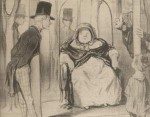
 « Tiens Poupoule », Charivari, 20 Aout 1843, Gallica Over the course of the 20th century, obesity came to be seen as a public health issue
« Tiens Poupoule », Charivari, 20 Aout 1843, Gallica Over the course of the 20th century, obesity came to be seen as a public health issue
As from the 90s, obesity has been perceived as an epidemic illness affecting some 17% of the French population (in 2019). Its prevalence, along with its growing mediatisation, sets this condition at the heart of current affairs. How is it to be defined? Historian Julia Csergo suggests viewing it as “excess fat mass leaving a person open to somatic, psychological and social consequences and affecting their quality of life”; hence the medical, then societal upshot of establishing a norm fit to determine the point at which it behoves to talk of “excess fat mass”. The moveability of that norm leads us to consider obesity as a product of history. If today this quantitative norm is set by the Body mass index (BMI) endorsed by the WHO, its invention by the Flemish scholar Auguste Quetelet harks back to the 19th century.
Obesity officially entered the medical realm at the beginning of the 18th century with an entry for the word in Furetière’s dictionary (1701). This term turns corpulence into a disease. Physicians were gradually discarding the traditional interpretations (based on humours or nerves) in favour of a mechanical conception of the body. According to combustion principle, much in the way a fire burns wood, the body burns combustibles: oxygen and food; if they are not burnt up, they are stored up in the shape of fat. From this model, physicians adduced two types of obesity: one, traditional caused by overindulging and a sedentary lifestyle, the other resulting from deficiencies in an organism unable to burn enough calories (here an anachronic use of a term associated to nutrition only at the end of the 19th century). Starting in the 19th century, some somatic effects of obesity were brought into light: tiredness and breathlessness – soon joined by intoxication, apoplexy, diabetes and, latterly, cancer.
Throughout the 19th century, aesthetic expectations grew, with the attendant implications for body appraisal. The pervasive usage of numbers towards getting measurements then weight evaluation, the prevalence of full-size mirrors sold in department stores, later the growth of leisure activities and seaside holidays bear this out. Coincidentally, social distinction prompted aesthetics. The portly bourgeois image is a 19th century common place, but such obesity was supposedly under control and a mark of authority. Found in the lower classes, an equivalent corpulence would be censured. Obesity was dapper, not working-class. However, the 20th century saw an upset of this traditional perception as no class was now spared by the growth in mass consumption. The harsh judgment passed on the poorest was reinforced in a society valuing yield, and thus muscle.
Equally, fat-shaming is gendered: fat women are more stigmatised than men. Historically, slenderness bespoke women’s basic weakness, their fragility. This thinking would evolve with 20th century women’s new-found status as dynamic types. Henceforth, flabby flesh bows to musculation. And yet, this mutation in no way blunts disparaging barbs.
In the 20th century the stigmatisation of obesity takes a fresh turn in the first-person essay, in which both physical and psychological suffering are given free rein. Such is Henri Béraud’s Le martyre de l’obèse awarded the literary prix Goncourt in 1922. In it, the eponymous fat man freely vents his feelings, prodded by a heightened self-awareness and from the growing need for self-confidence in an increasingly individualistic society. Psychological suffering, nettled with childish jibes, grows with the inability to seduce a mate, to recognise oneself in one’s own body. Such sufferers further endure unsuccessful cures that only undermine what self-respect they had left. Stigmatisation had shifted in the 20s: no longer greedy or lazy, the obese is now a therapy-refuser. In Beraud’s words he has become a martyr.
In the ensuing decades, obesity would rate as a public health issue. The dysfunction’s politization was not abrupt but rather the result of a long process wherein an obese person’s physical, social and mental health is in turn brought into question. This has had several positive consequences: For one thing, the growing mediatisation of obesity at the end of the 20th century via advertising, the press and the film industry yielded such popular documentaries as Super-Size me (2004). For another, enshrining in law. In France, a preventive law voted in 2007 instated motivational messaging designed to draw public awareness to healthy eating: “avoid grazing”, “make sure you eat your five a day”.
Follow the reading on the dictionnary : Aerobics- Tattoos
Références :
Georges VIGARELLO, Les métamorphoses du gras. Histoire de l’obésité, Seuil, 2010.
Julia CSERGO, Trop gros ? L’obésité et ses représentations, Autrement, 2009.
To quote this paper : Pauline Bourdais, "Obesity" in Hervé Guillemain (dir.), DicoPolHiS, Le Mans Université, 2021.